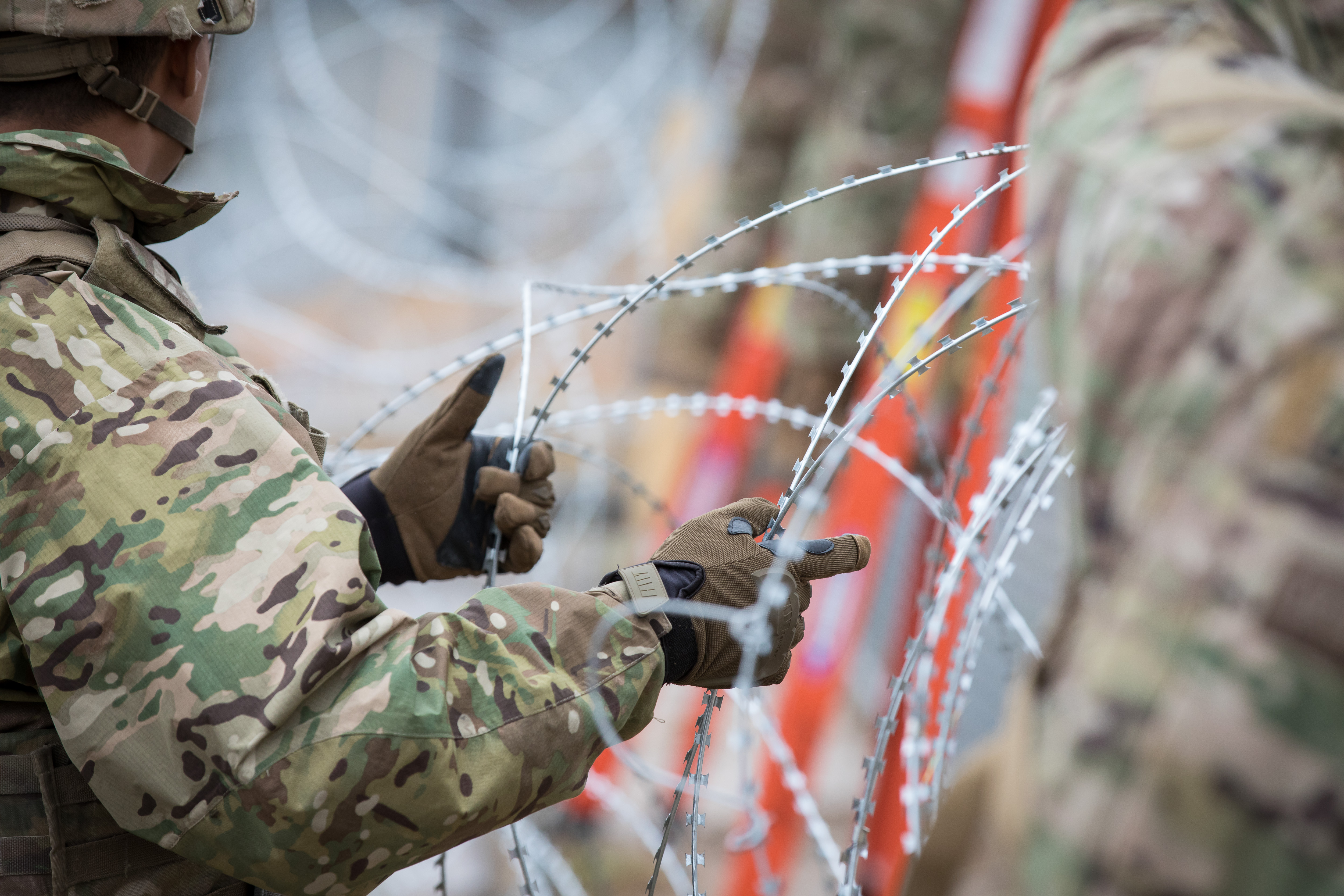Texas, Military Federalism, and the Southern Border
Interstate support for Texas’s border operations underscore states’ meaningful, but limited, independent authority to deploy military personnel for domestic operations.

Published by The Lawfare Institute
in Cooperation With

The long-simmering dispute between Texas and the federal government over the enforcement of immigration laws at the U.S.-Mexico border has intensified significantly of late. While Texas Gov. Greg Abbott’s Operation Lone Star, which employs the Texas National Guard and other state personnel to conduct border security operations, was launched in 2021, recent operational and rhetorical escalations have brought us dangerously close to physical confrontation between the state and federal governments.
There is, of course, the ongoing litigation concerning Texas’s controversial immigration law, Senate Bill 4 (SB4), which makes it a state crime to unlawfully cross the Texas-Mexico border and, among other things, purports to empower Texas state judges to order people convicted of that crime removed from the country. But that is not the focus of this piece.
Operationally, Texas has deployed numerous barriers on both land and water that impede the federal government’s border security operations. The Supreme Court vacated a U.S. Court of Appeals for the Fifth Circuit order prohibiting the federal government from removing concertina wire that Texas officials had put in place. Subsequently, Abbott denounced the Biden administration for allegedly violating Article IV, Section 4, of the U.S. Constitution by failing to protect Texas against an influx of undocumented migrants that Abbott calls an “invasion.” Abbott also pledged to continue to use state military and law enforcement personnel to prevent migrant crossings.
Twenty-five Republican governors subsequently joined Abbott in asserting that this “invasion” triggers their states’ constitutional right to defy the federal government in pursuit of their own “self-defense” based on Article I, Section 10, of the Constitution, notwithstanding the legal infirmity of this position. More recently, Abbott has ordered the construction of a permanent military base for 2,300 troops at the border, has continued to install razor wire, and has deployed troops to physically bar would-be asylum-seekers from accessing locations where they could file an asylum application.
And while Texas has thus far refrained from defying any federal court orders, Abbott’s refusal to back down has prompted some observers to call on President Biden to consider federalizing the Texas National Guard by invoking the Insurrection Act. The Insurrection Act includes a few statutory authorities, but the most on-point provision provides that (emphasis added):
Whenever the President considers that unlawful obstructions, combinations, or assemblages, or rebellion against the authority of the United States, make it impracticable to enforce the laws of the United States in any State by the ordinary course of judicial proceedings, he may call into Federal service such of the militia of any State, and use such of the armed forces, as he considers necessary to enforce those laws or to suppress the rebellion.
Putting aside whether Texas’s actions have sufficiently obstructed federal law enforcement efforts to justify the invocation of Section 252 or any other provision of the Insurrection Act, Abbott’s bellicose tone brings to mind state governors’ defiance of federal law during the civil rights era. President Eisenhower, for example, invoked the Insurrection Act to federalize the Arkansas National Guard, thereby preventing the governor from using these troops to block Black students from integrating Central High School in Little Rock. President Kennedy did much the same in 1963 by invoking the Insurrection Act to federalize the Alabama National Guard so that the governor could not use them to prevent Black students from enrolling in segregated public schools.
But the military deployments at the southern border today, and the contemporary legal architecture surrounding them are, in at least two respects, far more complicated than these historical examples. And invoking the Insurrection Act to federalize the Texas National Guard is not a panacea for the tensions between state and federal authorities on the southern border. In fact, state deployments of troops outside the federal chain of command are bolstered substantially by federal statutory authorizations that either did not exist or were not implicated in these previous situations in which presidents invoked the Insurrection Act. At the same time, these provisions of federal law also provide some options for the federal government to prevent states from exploiting these authorities to undermine federal power.
Interstate Military Support
The first set of authorities that distinguish the current moment from the civil rights era are located in the Emergency Management Assistance Compact (EMAC), an interstate compact Congress authorized in 1996. The EMAC enables a wide range of state-to-state support; its stated purpose is “to provide for mutual assistance between the states ... in managing any emergency disaster that is duly declared by the Governor of the affected state, whether arising from natural disaster, technological hazard, man-made disaster, civil emergency aspects of resources shortages, community disorders, insurgency, or enemy attack.” It also explicitly notes that states will provide EMAC support through National Guard forces.
Numerous states have made concrete commitments to provide Texas with military and law enforcement support through the EMAC. For example, on Feb. 1, Gov. Ron DeSantis announced the deployment of approximately 1,000 Florida National Guard personnel to support Operation Lone Star. On Feb. 20, Missouri pledged 200 members of the National Guard and nearly two dozen state law enforcement personnel. More than eight additional states either have committed to providing additional National Guard support or are poised to provide such support in the near future.
We don’t mean to overstate the practical significance of these commitments. Many of these states have been supporting Operation Lone Star with National Guard and law enforcement personnel since at least the middle of 2023. And some of these deployments are tiny (Utah, for example, has pledged fewer than a dozen soldiers to the effort). Nevertheless, when taken together with the thousands of federal military personnel that the Department of Defense mobilized to support the Department of Homeland Security at the southern border—many of whom may themselves be members of the National Guard mobilized into federal duty pursuant to Biden’s April 2023 national emergency declaration—these overlapping deployments make for a crowded border.
Article XIII of the EMAC provides two important limits on the use of National Guard personnel. First, it provides that the compact doesn’t permit deploying members of the National Guard outside of their home state in “any emergency for which the President is authorized by law to call into federal service the militia”—including instances in which the president has invoked the Insurrection Act. Second, Article XIII bars National Guard personnel from engaging in any activities that would be prohibited under the Posse Comitatus Act, which forbids the use of U.S. armed forces in civilian law enforcement operations inside the United States.
National Guard support of Operation Lone Star from outside Texas may violate the first limitation in Article XIII—even though Biden has not invoked the Insurrection Act.
Since December 2021, Biden has declared a national emergency with respect to the global illicit drug trade (this national emergency was most recently extended for another year in December 2023). And in April 2023, Biden authorized the secretary of defense to mobilize National Guard personnel into federal service under 10 U.S.C. § 12302 to respond to this national emergency. Although Biden’s narcotics trafficking emergency declaration lacks an explicit geographic scope, it is clear that the primary site of ongoing Defense Department military support to the Department of Homeland Security’s drug interdiction efforts is at the southern border.
A rather straightforward argument could be made, therefore, that the ongoing emergency at the southern border—which, under provisions of the National Emergencies Act and 10 U.S.C. § 12302, permits the president “by law to call into federal service the militia” (to borrow language from the EMAC)—precludes using the EMAC to provide out-of-state National Guard personnel support for Operation Lone Star. Of course, this case would be stronger if the executive order authorizing mobilization under § 12302 specifically mentioned the southern border. The Biden administration will have an opportunity to provide that level of detail if it reauthorizes this mobilization authority, which expires this month.
The second limitation contained in Article XIII is a comparatively weaker guarantor of federal military supremacy in this context. First, there is a three-way circuit split as to the precise scope of activities prohibited under the Posse Comitatus Act, though each of the relevant tests seeks to ensure that the military is limited to playing a supporting role in civilian law enforcement. Furthermore, the executive branch maintains that a relatively wide range of activities, authorized both under statute and under theories of inherent constitutional authority, many of which are at least adjacent to law enforcement operations, are permitted under the act. For example, the Justice Department’s Office of Legal Counsel has opined that the president has inherent constitutional authority to use military personnel to protect federal property, persons, and functions without implicating the act. Historically, the executive branch has availed itself of this asserted carve-out to use military personnel to protect mail cars and a wide range of federal buildings, among other entities and activities with a federal nexus. States could easily make these same arguments to justify conducting a similarly wide range of protective duties at the southern border.
State Defense Forces
Federal law permits states and territories to maintain troops in peacetime only within a National Guard or, since 1940, a separate state defense force. These separate self-defense forces, codified at 32 U.S.C. § 109(c), “may be used within the jurisdiction concerned, as its chief executive ... considers necessary.” Unlike National Guard personnel, members of a state self-defense force may not be called into federal service.
During World War I, Congress authorized the states to form “home guards” to take over the functions normally performed by the National Guard, because the entirety of each state’s and territory’s National Guard was occupied by the federal war effort. On the eve of the United States’s entry into World War II, Congress resupplied this authority by enacting § 109(c)’s precursor to once again ensure that states and territories (territories were added at this stage) had sufficient means of self-defense if their National Guard units were brought into federal military service. The statutory language authorizing these self-defense forces varied through the middle of the 1950s. However, constant throughout this period was a provision empowering the War Department to set standards for the training and organization of these state forces. This standard-setting mechanism for federal regulation was removed in 1955, but states’ authority to form these defense units remained on the books.
Which leaves us with the non-federal defense forces present in many states and territories today—a military force that can be used at the discretion of each governor, without any federal oversight, and that cannot be brought into federal military service by the president or any other federal military official. The only statutory limitation on a governor’s use of these forces is that they be contained “within the jurisdiction concerned.” The most natural reading of this somewhat ambiguous language is that the self-defense force may be used only in its home state or territory. This interpretation is supported by the structure of the statute’s text, since the prior sentence specifies the jurisdictions permitted to maintain such forces, and includes the states, Puerto Rico, the District of Columbia, Guam, and the Virgin Islands. This reading is also consistent with the original purpose of these forces—to ensure that states maintain a military self-defense force when their National Guard units are on federal duty.
Abbott’s use of the Texas Guard (the state’s self-defense force, not the National Guard) to help secure the southern border in ways that are consistent with federal immigration law aligns with how both federal and state law envision governors may use such forces. So, even if the president were to call the National Guard into federal service, under the Insurrection Act or otherwise, the governor would still have recourse to an independent military force to pursue his immigration policy. While it is certainly troubling that federal law seemingly facilitates the potential conflict of state and federal military forces, the Texas Guard is relatively small—in 2022 there were only 1,817 personnel, as compared to the 22,893 soldiers and airmen of the Texas National Guard. And this potential for tension is not new. Even though Presidents Eisenhower and Kennedy could bring the National Guard under federal control through the Insurrection Act, they had no ability to limit how governors used state law enforcement personnel to oppose federal authority.
What distinguishes this case from exercises of state military and police power in the civil rights era, however, is the use of these self-defense forces across state lines—Gov. DeSantis has pledged to send not only Florida National Guard personnel to Texas’s aid but also Florida State Guard support. Use of the Florida State Guard in Texas, however, would seem to violate the limitations contained in § 109. Moreover, it is only in the current legislative session that DeSantis is pushing through a change to Florida law to authorize such extraterritorial use of the state guard. But there are other states that already have such authorizations—all in violation of federal law—already on the books. To name just a few, Texas, South Carolina, and—potentially—Virginia (reading two statutory provisions in conjunction) all explicitly authorize their defense forces to operate outside the state. To date, the federal government does not seem to have objected to these provisions.
Looking to the Future
As tensions between state and federal authorities at the southern border grow, state officials seem increasingly bellicose. While both the federal government and Texas have demonstrated restraint thus far, the intensity of the political stakes will only rise as the election approaches, raising the frightening specter of significant conflict between federal and state authorities. This potential for conflict is exacerbated, in substantial part, by relatively arcane federal statutes that devolve the authority to use military force during times of emergency from the federal to the state level. While such a devolution may make practical sense in less politically charged times, they now facilitate the ratcheting of federalism conflicts in what is shaping up to be another deeply fraught, and potentially violent, election year.
This is not to say that the federal government is without recourse to rein in how states are using the powers afforded by the EMAC and § 109. Both of them contain limitations that the federal government, through litigation, can use to restrict how states use military force to frustrate federal policy. But these strategies are not a cure-all, and if states like Texas are determined to undermine federal immigration enforcement efforts, the federal government might be forced into a direct confrontation that, to date, it has studiously avoided.





